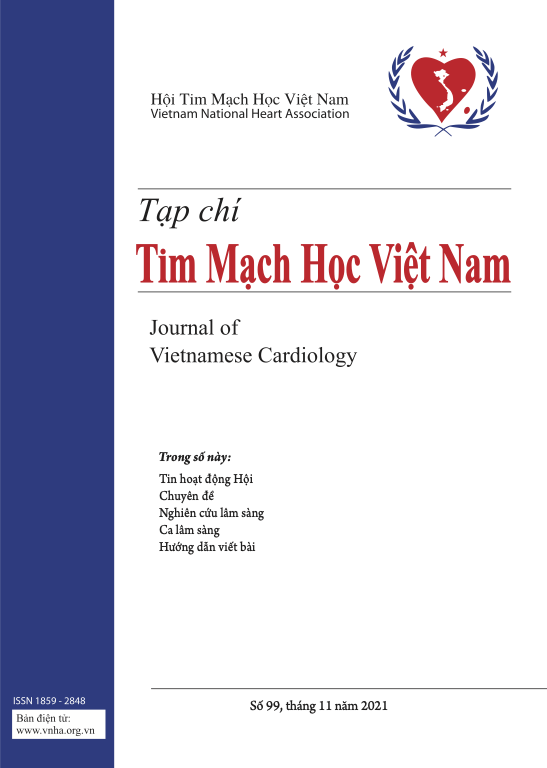The value of Hendry’s Score in predicting reduced ejection fraction in chronic heart failure patients with sinus rhythm
DOI:
https://doi.org/10.58354/jvc.112E.2024.712Từ khóa:
Chronic heart failure, Electrocardiogram features, Hendry’s Score, Type of heart failureTóm tắt
Objectives: To evaluate the role of Hendry’s score based on the electrocardiogram in predicting heart failure with reduced ejection fraction.
Methods: This is a cross-sectional study, including 91 inpatient heart failure patients at the Vietnam Heart Institute, divided into two groups: heart failure with reduced left ventricular ejection fraction (EF ≤ 40 %) and heart failure with preserved left ventricular ejection fraction (EF ≥ 50%). The collected information included the general characteristics of the disease group (age, gender, etiology, clinical symptoms), blood test NT-proBNP, creatinine, electrolytes, echocardiogram, and electrocardiogram.
Results: Forty-seven people were diagnosed with HFpEF, and 44 suffered from HFrEF. Multiple logistic regression analysis revealed certain ECG variables that were independent predictors of HFrEF, i.e., left atrial hypertrophy (LAH), QRS duration > 100 ms, right bundle branch block (RBBB), ST-T segment changes, and prolongation of the QT interval. Based on Hendry’s Score, we obtained a score for HFpEF of -1 to +3. At the same time, HFrEF had a score of +4 to +6 with 81.3% sensitivity, 84% specificity, a 70.5% positive predictive value, an 87.2% negative predictive value, and an accuracy of 86%.
Conclusions: The scoring system derived from this study, including the presence or absence of LAH, QRS duration > 100 ms, RBBB, ST-T segment changes, and prolongation of the QT interval can be used to predict the type of HF with satisfactory sensitivity and specificity.
Tài liệu tham khảo
Roger V.L. (2013). Epidemiology of Heart Failure. Circulation Research, 113(6), 646–659.
![]()
Ponikowski P., Voors A.A., Anker S.D. et al. (2016). 2016 ESC Guidelines for the diagnosis and treatment of acute and chronic heart failure: The Task Force for the diagnosis and treatment of acute and chronic heart failure of the European Society of Cardiology (ESC)Developed with the special contribution of the Heart Failure Association (HFA) of the ESC. European Heart Journal, 37(27), 2129–2200.
![]()
Hendry P.B., Krisdinarti L., và Erika M. (2016). Scoring System Based on Electrocardiogram Features to Predict the Type of Heart Failure in Patients With Chronic Heart Failure. Cardiol Res, 7(3), 110–116.
![]()
Bhatia R.S., Tu J.V., Lee D.S. et al. (2006). Outcome of heart failure with preserved ejection fraction in a population-based study. N Engl J Med, 355(3), 260–269.
![]()
Owan T.E., Hodge D.O., Herges R.M. et al. (2006). Trends in Prevalence and Outcome of Heart Failure with Preserved Ejection Fraction. N Engl J Med 2006; 355:251-259.
![]()
Tsutsui H., Tsuchihashi-Makaya M., và Kinugawa S. (2010). Clinical characteristics and outcomes of heart failure with preserved ejection fraction: Lessons from epidemiological studies. Journal of Cardiology, 55(1), 13–22.
![]()
Paulus W.J. và Tschöpe C. (2013). A Novel Paradigm for Heart Failure With Preserved Ejection Fraction: Comorbidities Drive Myocardial Dysfunction and Remodeling Through Coronary Microvascular Endothelial Inflammation. Journal of the American College of Cardiology, 62(4), 263–271.
![]()
Van Veldhuisen D.J., Linssen G.C.M., Jaarsma T. et al. (2013). B-Type Natriuretic Peptide and Prognosis in Heart Failure Patients With Preserved and Reduced Ejection Fraction. Journal of the American College of Cardiology, 61(14), 1498–1506.
![]()
Karaye K.M. và Sani M.U. (2008). Electrocardiographic abnormalities in patients with heart failure. Cardiovascular Journal of Africa, 19(1), 22.
![]()
McMurray JJ, Adamopoulos S, Anker SD, Auricchio A, Bohm M, Dickstein K, Falk V. et al. ESC Guidelines for diagnosing and treating acute and chronic heart failure 2012: The Task Force for the Diagnosis and Treatment of Acute and Chronic Heart Failure 2012 of the European Society of Cardiology. Developed in collaboration with the Heart Failure Association (HFA) of the ESC. Eur Heart J. 2012;33(14):1787–1847.
![]()








